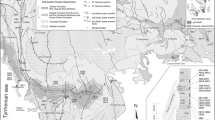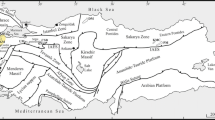Abstract.
On Ile de Groix, Variscan metamorphic former tholeiitic and alkaline basalts occur as glaucophane-eclogites, blueschists and greenschists in isolated lenses and layers within metapelites. Whole-rock δ18OSMOW values of the metabasites show limited variations (10.4–12.0‰) and no systematic differences among rock types and metamorphic grades. This provides no argument for large-scale blueschist-to-greenschist transformation driven by infiltration of externally derived fluids. Metamorphic mineralogical changes should have been triggered by internal fluids. Element variations in interlayered blue- and greenschists can be attributed to magmatic fractionation. Assemblages with garnet, clinopyroxene and glaucophane of a high-pressure/low-temperature (HP–LT) metamorphism M1, and NaCa-amphiboles (barroisite, magnesiohornblende, actinolite) of a medium-pressure/medium-temperature metamorphism M2 crystallized during deformation D1. Detailed core-rim zonation profiles display increasing and then decreasing AlIV in glaucophane of M1. NaCa-amphiboles of M2, mantling glaucophane and crystallized in porphyroblasts, show first increasing, then decreasing, AlIV and AlVI. Empirically calibrated thermobarometers allowed P–T path reconstructions. In glaucophane-eclogites of a metamorphic zone I, a prograde evolution to M1 peak conditions at 400–500°C/10–12 kbar was followed by a retrograde P–T path within the glaucophane stability field. The subsequent M2 evolution was again prograde up to >600°C at 8 kbar and then retrograde. Similarly, in metamorphic zones II and III, prograde and retrograde paths of M1 and M2 at lower maximal temperatures and pressures exist. The almost complete metamorphic cycle during M2 signalizes that the HP–LT rocks escaped from an early erosion by a moderate second burial event and explains the long-lasting slow uplift with low average cooling rates.
Similar content being viewed by others
Author information
Authors and Affiliations
Additional information
Electronic Publication
Rights and permissions
About this article
Cite this article
Schulz, B., Triboulet, C., Audren, C. et al. Two-stage prograde and retrograde Variscan metamorphism of glaucophane-eclogites, blueschists and greenschists from Ile de Groix (Brittany, France). Int J Earth Sci 90, 871–889 (2001). https://doi.org/10.1007/s005310000156
Received:
Accepted:
Issue Date:
DOI: https://doi.org/10.1007/s005310000156




